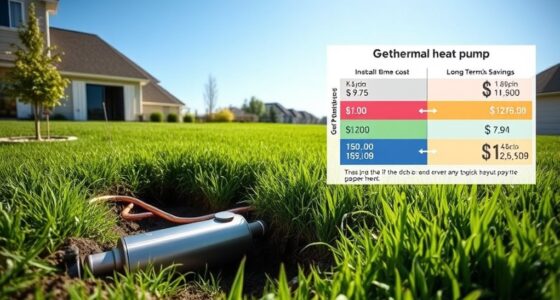A life cycle analysis of geothermal heat pump systems shows that sustainable material choices and efficient installation reduce environmental impacts from start to finish. Using recycled or biodegradable materials during manufacturing cuts resource use and waste. Proper installation, with local sourcing and minimal invasive methods, saves energy. Operational efficiency depends on durable materials and proper maintenance. Recycling parts at decommissioning further lessens waste. To understand how each phase impacts the environment, explore further for detailed insights.
Key Takeaways
- Material selection and manufacturing methods influence the environmental footprint of geothermal heat pump systems throughout their lifecycle.
- Installation practices and site assessment affect energy consumption and long-term operational efficiency.
- Operational performance benefits from durable, sustainable materials that reduce maintenance and extend system lifespan.
- Decommissioning and recycling of components minimize waste and environmental impact at the end of the system’s life.
- Lifecycle analysis evaluates environmental impacts from construction to disposal, emphasizing resource use, emissions, and sustainability.

Geothermal heat pump systems are gaining popularity as an energy-efficient alternative for heating and cooling buildings, but understanding their environmental impact requires a thorough life cycle analysis. When evaluating these systems, energy efficiency is often highlighted as their main benefit, yet it’s essential to consider how materials used in manufacturing and installation influence overall sustainability. From the initial planning stages to eventual decommissioning, every phase impacts the environment, and focusing on material sustainability helps minimize negative effects.
During manufacturing, the choice of materials plays a vital role in the system’s environmental footprint. Components such as pipes, heat exchangers, and compressors are typically made from metals, plastics, and other durable materials. Opting for sustainable materials—those that are recyclable or have low embodied energy—can substantially reduce environmental harm. For example, using recycled metals or biodegradable plastics minimizes resource extraction and waste generation. This focus on material sustainability not only reduces the ecological impact but also enhances the system’s overall energy efficiency by ensuring that components last longer and require less frequent replacement. Additionally, integrating advanced manufacturing techniques can further reduce waste and energy consumption during production.
Installation processes also influence the environmental profile of geothermal heat pump systems. Proper site assessment and efficient drilling methods decrease energy consumption during installation. When you prioritize sustainable practices—like utilizing less invasive drilling techniques or sourcing materials locally—you reduce the carbon footprint associated with transportation and construction. Additionally, integrating efficient design principles ensures the system operates at maximum energy efficiency once in use, lowering energy consumption and greenhouse gas emissions over its lifespan.
Operational efficiency is another key aspect. Geothermal heat pumps are known for their superior energy efficiency compared to traditional HVAC systems, often reducing energy use by 30-60%. This efficiency results from their ability to leverage the stable temperature of the earth to provide heating and cooling. However, maintaining this performance requires high-quality materials that can withstand continuous operation without degrading. Choosing durable, sustainable materials ensures the system maintains peak efficiency over the years, further reducing its environmental impact.
When it’s time to decommission or upgrade, material sustainability becomes essential again. Recyclability of system components allows valuable materials to be reclaimed and reused, closing the environmental loop. Proper disposal prevents hazardous materials from contaminating the environment and reduces waste. Ultimately, by carefully considering material choices throughout the system’s life cycle, you can maximize the energy efficiency benefits while minimizing environmental harm. This holistic approach ensures geothermal systems remain a genuinely sustainable solution for heating and cooling needs, aligning performance with environmental responsibility.
Frequently Asked Questions
How Do Geothermal Heat Pumps Compare to Traditional HVAC Systems Environmentally?
You’ll find geothermal heat pumps are more environmentally friendly than traditional HVAC systems because they use renewable energy from the earth, reducing your carbon footprint. Unlike conventional systems that burn fossil fuels, geothermal units operate efficiently year-round, emitting fewer greenhouse gases. By choosing geothermal, you contribute to a cleaner environment and lower your overall impact, making it a smarter, more sustainable option for heating and cooling your home.
What Are the Long-Term Maintenance Costs for Geothermal Systems?
Imagine installing a geothermal system in your home. Long-term, you’ll likely face modest maintenance costs, mainly due to corrosion issues affecting components like loops and pumps. Typically, you might need to replace parts after 10-20 years, but these costs are generally lower than traditional HVAC repairs. Regular inspections can catch corrosion early, reducing unexpected expenses and keeping your system running efficiently for decades.
How Does Local Geology Affect Geothermal Heat Pump Performance?
Your geothermal heat pump performance heavily depends on local geology, especially soil composition and groundwater flow. If the soil is highly conductive, heat transfer improves, boosting efficiency. Conversely, poor soil or rocky terrain hampers heat exchange. Groundwater flow can facilitate or hinder heat transfer; steady flow enhances system performance, while stagnant water reduces efficiency. Understanding these geological factors helps you optimize system design and guarantee reliable operation.
Are There Any Government Incentives for Installing Geothermal Systems?
Did you know that over 20 states offer tax incentives or rebate programs for geothermal system installations? These government incentives can notably reduce your upfront costs. You might qualify for tax credits, rebates, or other financial benefits that make switching to a geothermal heat pump more affordable. Check your state’s programs to see what incentives are available, and take advantage of these opportunities to save money and boost your home’s energy efficiency.
What Is the Typical Lifespan of a Geothermal Heat Pump System?
A geothermal heat pump system typically lasts 20 to 25 years, but durability factors and component longevity can extend this lifespan. You should regularly maintain the system and guarantee high-quality components to maximize its durability. Proper installation, efficient operation, and timely repairs help you get the most out of your investment, ensuring your geothermal system continues to perform reliably for decades.
Conclusion
By now, you see that geothermal heat pump systems have a considerably lower environmental impact over their lifespan, with some studies showing up to 50% reduced emissions compared to traditional heating methods. Imagine saving nearly half the carbon footprint just by switching to geothermal! Plus, with a lifespan of 20-25 years, you’re not only helping the planet but also investing in long-term savings. It’s a smart choice for a sustainable, cost-effective future.









